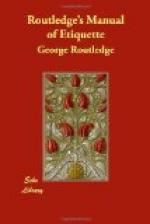In order to dress strictly according to fashion, and to comply with the ever-changing caprice, it is necessary to have a large and well-filled purse, and a wardrobe that is not too extensive; because, as the fashion varies with almost every season, a large number of dresses involves either a great and needless waste of money, or the necessity of always being a little behind the fashion of the day. Besides which, as this capricious goddess has prescribed what shall be worn for driving, for walking, for morning, noon, and night; and demi-toilettes and full-dress toilettes have each their own peculiarities, it really becomes a very serious item of expenditure for such ladies as make it the business of their lives to follow the fashions of the day.
Fashion prescribes rules for all. All classes of society bow, more or less, to her decrees. The fine lady who frequents the Court, as well as the servant-girl who sweeps out the area of a London lodging-house, and all the intermediate classes, are guided by Fashion. Crinolines and bonnets prove this, as well as the length of the skirts which are suffered to trail along in all the dirt and dust of pavement and crossings. It always takes some time before a fashion which has been adopted by the higher orders prevails among the lower; but, if it is a fashion which survives beyond the moment, it invariably finds its way downward in the course of time. Fashion prescribes the size and shape of bonnets, the make of gowns, their length and their size—the number of breadths and gores—the trimmings, the petticoats, which have become like a second gown, and all the other paraphernalia of a lady’s toilette. There is no part of a lady’s dress too minute for her inspection and care and legislation. The colour of gloves, the dye of hair, the application of false hair, the make of boots and shoes, the choice of ornaments, are all ordered and arranged. Fashion is a sort of “act of uniformity,” which would bring all flights of fancy within certain prescribed limits. It defines the boundaries within which ladies may safely indulge their own conceits.
The best-dressed persons are not always those who are led blindfold by the prevailing fashion, nor by any means those who are strong-minded enough to defy it, and set it at nought. Any one who defies the fashion of the day, and, when long skirts and small saucer-like bonnets prevail, dares to walk abroad with very short petticoats, which she holds up unnecessarily high; displaying a foot and ankle that had better be hidden out of sight; who spurns a crinoline, and therefore looks like a whipping post; who wears a many-coloured shawl because cloaks and mantles are the rage; who adorns her head with a bonnet that is of the coal-scuttle cut, over which she fastens a large, coloured gauze veil, because she desires to protest, as far as she can, against the innovations of fashion; such a one will never attract, nor influence the public mind. She will provoke a smile, but will never recommend her own peculiar and independent style of dress. And she who follows fashion like a slave, wears what is prescribed without regard to her own personal appearance; who considers neither her age, nor her figure, nor her station, nor her means; who simply allows herself to be an advertisement for the milliner she employs, will often appear eccentric, and generally ill-dressed.




